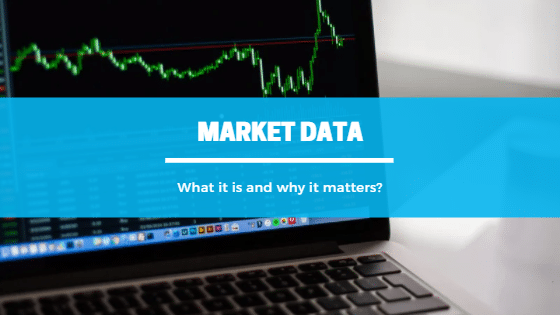Market data consists of the live streaming of trade-associated details such as prices, bid/ask quotes, and market volume. Trading places provide reports on different assets as well as financial instruments. Then, this information goes to traders and companies.
Market data can be found across many global markets including forex, stocks, commodities, and indices. It’s utilized by traders to estimate the worth of many assets as well as inform their approach to entering and exiting trades. Market data has a very simple purpose!
Utilizing this data is to obtain as many details about the asset you’re planning to trade to determine the market risks and the influence of live news releases. In today’s article, I will discuss market data and why it’s so important to traders and firms, so let’s begin.
What Is Market Data For?
Market data is utilized by traders and firms in real-time for making on-the-spot trading decisions (should I purchase or should I sell?) Historical market data can also be used to evaluate trends and help estimate market risks on investment portfolios.
In the finance world, market data stands for price and other associated information for various financial instruments reported by trading places such as stock exchanges. The data enables investors and traders to see the latest prices and historical trends for instruments.
Those financial instruments include fixed-income products, equities, currencies, and derivatives. Market data is also the main part of financial news coverage. You have probably noticed it on news websites like Reuters or BBC that release the latest market data information.
If you take a look at the Financial Times, for instance, you will notice the pages with very detailed market data at the back which is common for financial newspapers. Nowadays, smartphone users have different apps that provide market data by hour, day, week, and year.
Overall, market data enables people and legal entities to see real-time prices of investment tools as well as determine historical trades. The stock market data, for instance, offer details like the time of the last quote and trade, the latest bid/ask prices, etc.
Where Can I Find Market Data?
Some of the most popular market data providers include Morningstar, Moody’s Analytics, Bloomberg, ICE Data Services, Markit, Dealogic, Thomson Reuters, and Perqin.
For instance, Thomson Reuters provides asset pricing data for over 2.5 million securities. Bloomberg, on the other hand, claims their market data feed ensures stronger global connectivity by providing data in real-time for over 35 million financial instruments across all asset classes.
The type of market data delivered varies by provider. However, they usually deliver data about financial instruments including bonds, shares, and so on, and data about companies.
The pricing data tends to be sold individually from other associated data like valuation information, firm performance, and reference data on other tools and entities themselves.
The delivery of market data
The delivery of market data associated with prices from exchanges is time-sensitive and specialized tech is utilized to deliver the data to both investors and traders.
The speed of price data delivery may be crucial in trading systems such as high-frequency trading, where computers change positions in just seconds. Market data sellers offer a broad selection of many delivery frequencies including delayed, end-of-day, and real-time.
They also provide different delivery methods including satellite, broadcast, VPN, private line, or internet. The value of data can be increased by adding on services like stock data, listing data, historical data, and time series. The reference data isn’t changing in real-time.
It’s a type of data associated with securities. Examples of reference data include identifier codes such as International Securities Identification Number, end-of-day pricing, the exchange securities trade on, the address and name of the issuing firm, the terms of securities, and any future corporate actions.
The terms of securities include interest rate, dividends, and maturity on bonds, while future corporate actions include proxy votes or stock splits.
The price information often comes from the stock exchanges, while reference data typically comes from the issuer. Also, before it’s released to traders or investors, it goes through financial data sellers that can reformat it, organize it, and solve visible issues in real-time.
Market data: Level 1 and level 2
What’s also important to know about market data is that it’s often split into 2 types, also known as level 1 and level 2. The level 2 market data offers more data than level 1.
Traders determine which one they need for making their decision. Then, they subscribe to that level via their broker. And level 1 and level 2 can have different prices depending on the broker.
Lever 1 market data offers all the data needed for trading most chart-based trading systems. Level 2, on the other hand, offers more detail. Meaning, it doesn’t just reveal the highest bid and offer. It also offers bids and offers at different prices.
Level 2 is also known as “the order book” because it shows the orders that have been submitted and are waiting to be executed. It’s referred to as “the market depth” because it reveals the number of contracts available at each of the bid/ask prices.
Why Are Data Market Costs Rising?
Over the last couple of decades, stock exchanges have improved a lot, especially during the 1990s when digital and virtual improvements meant information could be transferred between various organizations quickly.
These improvements gave stock exchanges the monopolistic ability to manage and monetize access to data as a new source of profit. The profit earned from market data, managed by Information Services, has increased massively over the last decade.
According to reports, Information Services earned about $1 billion in 2005 and by 2019, the number had increased to $6 billion. The number increased by over 12% per year over the last decade.
With the booming profit levels and minimal costs to generate market data at exchanges, reports show a great operating margin of 76% and profit margins that double those of big data providers or triple that of big investment banks.
Forex market data
The foreign exchange market data comes from different sources. Some of the biggest forex market data providers include Bloomberg, Reuters, MarketWatch.com, the Wall Street Journal, CNN, CNBC, etc.
Other options for real-time market data delivery include forex trading platforms. Forex brokers provide live news feeds right in their software to deliver people easy and quick access to many news and events in the currency markets.
Pros And Cons Of Market Data
Market data stands for information that helps traders and companies to make better financial decisions.
They also help businesses understand their customers and competitors. You can collect market data in a wide range of ways as long as they comply with data protection legislation.
Market data is a broad term utilized for the financial details necessary for performing research, trading, accounting, and analyzing financial instruments of different asset classes on the global markets.
Now, let’s summarize the key advantages and disadvantages of market data.
Pros of market data
As I already established, market data is produced in real-time. Meaning, it can be utilized to make quick and well-informed trading decisions. It can also be utilized to access historical data that plays a key part in technical analysis and can be quite useful when forming a strategy for future trades.
Market data can be found in one spot under a ticker symbol, which makes it easier to access, and pricing data is stored individually from the rest of the data. Still, some market data providers will decide to offer fundamentals like reference data, company performance reports, and market valuations.
Cons of market data
Market data is time-sensitive! So, real-time delivery is important because prices can change quickly and traders need to make quick and well-informed decisions about entering and exiting trades.
And with market data, there’s always the risk of lags and latency in the delivery part, especially because the data can be pouring from different trading places all over the world. So, when picking the right data provider, it’s crucial to consider their reliability and capacities to offer accurate data quickly.
Conclusion
Market data stands for various types of financial information that people use when conducting research, trading, analyzing, and accounting for financial tools of all assets on global markets.
In terms of variety, market data ranges from regular, individual, and basic services and contents to more complex information flows and data processing platforms serving several business areas.
The management of market data refers to the transferring of services and items associated with market data as well as to the management of contractual connections with data providers such as markets, data sources, and data vendors which collect and transfer data from the sources to the clients.




